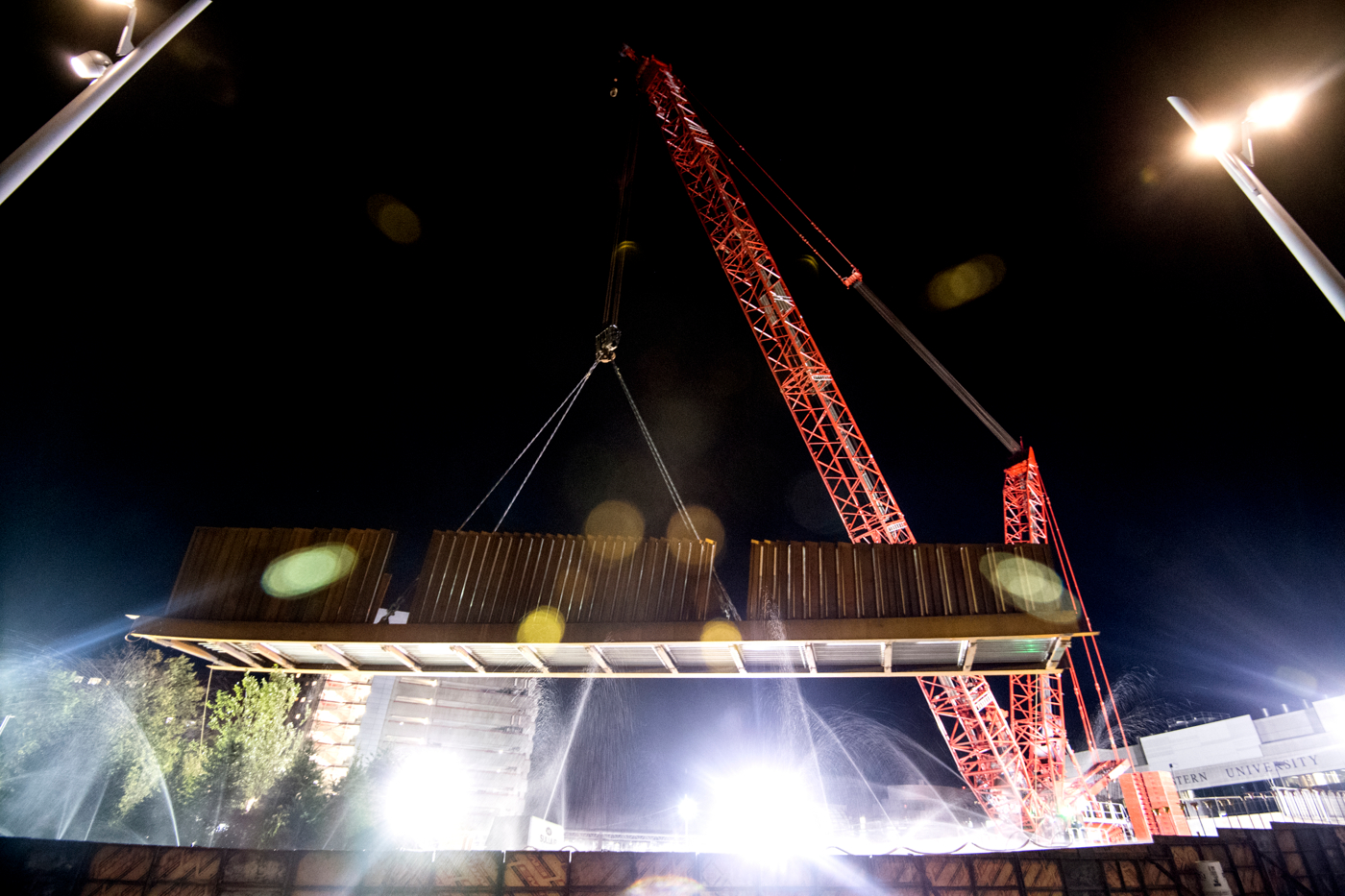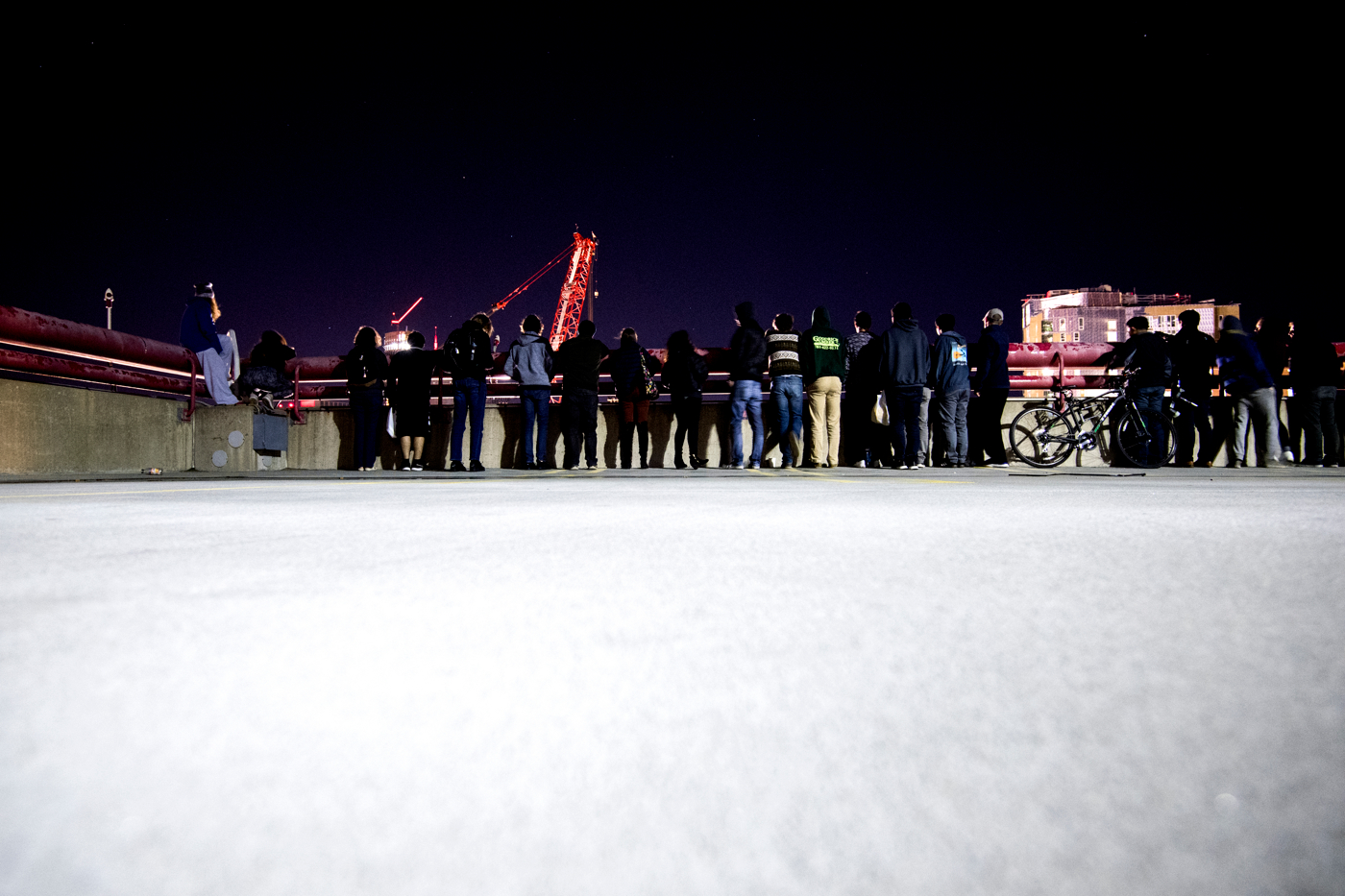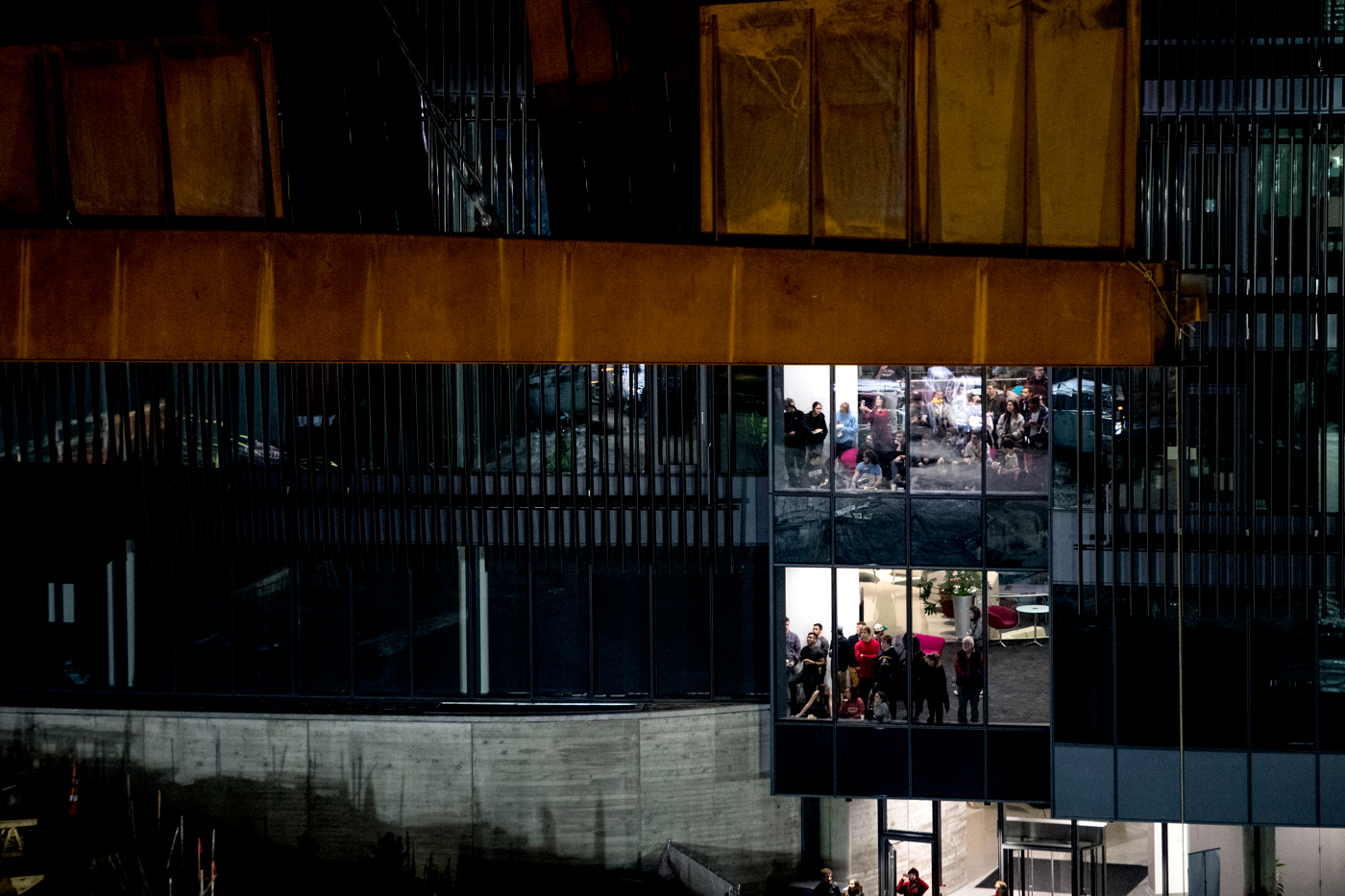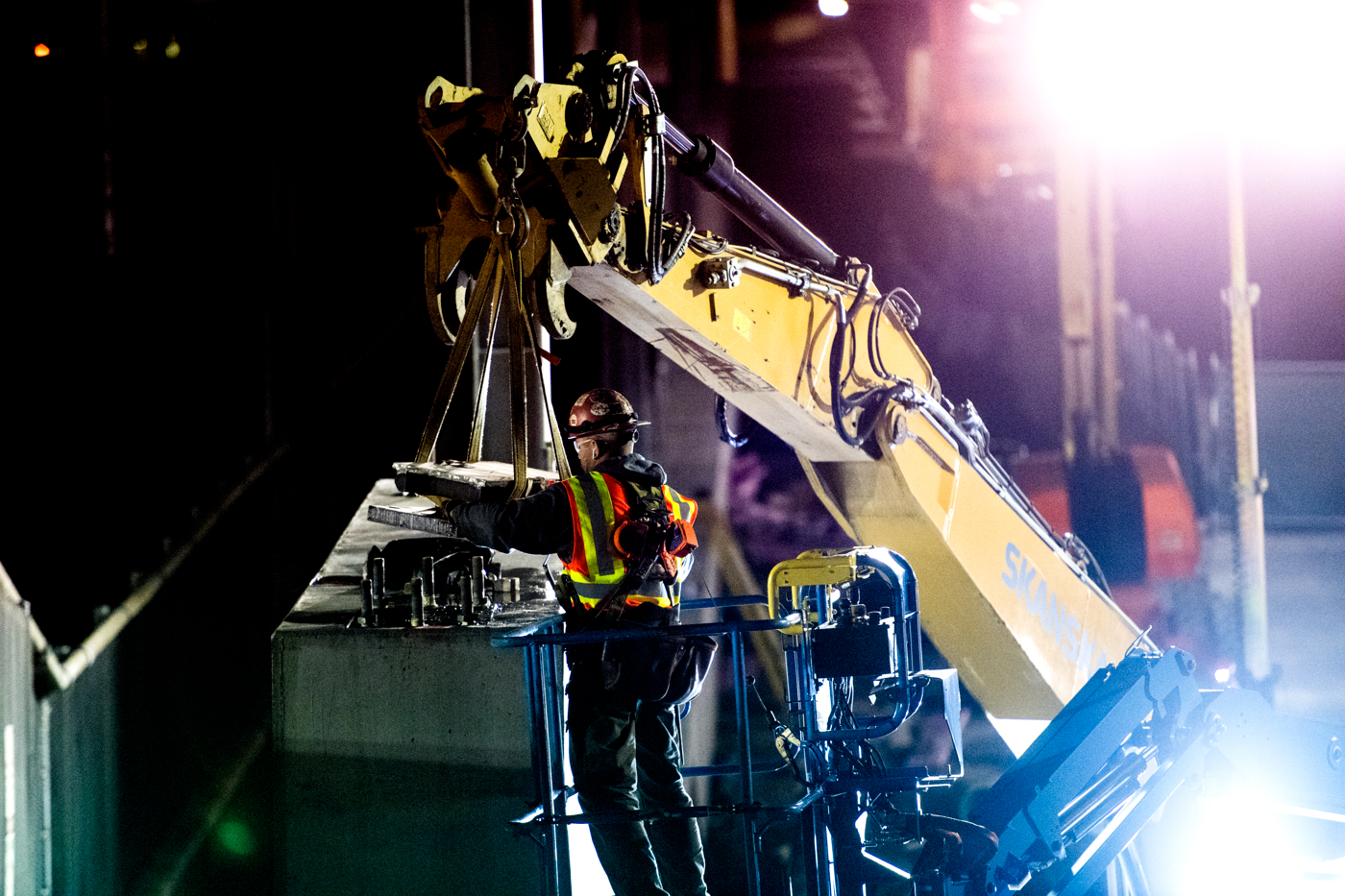New Pedestrian Bridge Connects ISEC to Main Campus
Early in the morning of October 14th, Northeastern hosted a Midnight Masters Class prior to the installation of a 132-foot-long section of the Pedestrian Crossing bridge that will link to two sides of the Northeastern campus over the MBTA tracks. Sammy Alshawabkeh, a civil master’s student, has been working on co-op with Skanska, the construction firm installing the bridge.
Source: News @ Northeastern
Northeastern’s Boston campus is about to be transformed. It will happen literally overnight.
Years of planning, investments, and a bold vision to reimagine Columbus Avenue in Boston will realize its next step when two spans of bridge, totaling 200 feet and 168 tons, are erected across the Amtrak and MBTA railroad tracks this weekend.
Early Saturday morning, as soon as the last orange line train has passed between the Ruggles and Massachusetts Avenue MBTA stations, electricity for the tracks will be shut off for as long as four hours. One of the largest cranes on the Eastern seaboard will lift the first span of bridge, 64 feet long, and thread its 47 tons into its place within the densely-occupied campus on the north side of the tracks.
And then, in the early hours Sunday, while the city is asleep, a similar action will be performed with greater weight and delicacy. This time the fire-engine-red Manitowoc MLC-650 crawler crane, which is 189 feet tall, will hoist another section of bridge that is twice as large as the first. The tension and urgency of this event will be underscored by the slow, cautionary path of the structure, 132 feet in length and 242,000 pounds, as it is raised, moved, and then lowered to its assigned location between the Interdisciplinary Science and Engineering Complex and the Ruggles Station.
A massive crane is set up to install the new pedestrian bridge at Northeastern, which will connect city neighborhoods and provide a safe route over the rails. Photo by Matthew Modoono/Northeastern University
The bridge will serve as a means of access to many destinations. In addition to furthering the university’s long-term plan to unify the campus, the state-of-the-art passageway will also link two neighborhoods that are home to the Boston campus.
Ralph Martin, Northeastern’s general counsel, said the new span expresses “an open university, where we invite people to travel in and across our campus.”
“What the bridge will do is bring two different communities together: the Roxbury side and the Fenway side,” he said.
The fusion of the Huntington Avenue side of the campus with the more recently-developed installations to the south was jump-started by Joseph E. Aoun. Not long after he became Northeastern’s seventh president in 2006 Aoun moved his office to Columbus Avenue.
“The challenge of having railroad tracks run through the middle of the campus is considerable,” said Kathy Spiegelman, vice president and chief of campus planning and development at Northeastern. “The addition of the bridge over the tracks, and the landscape that leads up to it from Columbus Avenue, is a corroborating part of identifying the fact that the campus is engaged with that part of the city.”
The new bridge extends Northeastern’s vision to reimagine Columbus Avenue. The development of International Village and the Interdisciplinary Science and Engineering Complex were followed in August by the reopening of the Carter Playground as a state-of-the-art recreational park, refurbished and maintained by the university at a cost of $108 million. Two months later comes the dramatic construction of a visually stunning bridge that promises to become a landmark for the 120-year-old university.
A vision of bridge-building
The assembly this weekend of the main pieces of the as-yet-unnamed bridge will be enhanced by further construction and landscaping, in order to be integrated with the communities it is meant to serve. The bridge is projected to be open for pedestrian traffic in 2019.
While the project will appear to have been framed in a matter of hours this weekend, the commitment to its design and construction began two years ago.
“It really is an art piece,” said Northeastern program director Cassandra McKenzie, who is directing the bridge project. “This is a statement from our university to the city of Boston to say we are on board for beautification, we are committed to art, we are committed to making these grand statements.”
Sammy Alshawabkeh, a second-year graduate student, currently on co-op at Skanska, works on the new pedestrian bridge at Northeastern. Photos by Matthew Modoono/Northeastern University
After the two spans have been coupled on Sunday by Skanska, the Swedish-based construction firm hired by Northeastern, its crews will begin work on adding the upright steel fins as tall as 18 feet that will serve as the walls to the bridge. As pedestrians make their way across the structure, gaps between the fins will fan open incrementally to reveal views of the Boston skyline.
“They will open to only one side,” McKenzie said. “We want you to look at the city of Boston.
“Every fin has a different angle. When you start, you can’t see much. But then as you start crossing the railroad tracks, they open up a little more, a little more, so you can see the city. It will totally open up to you, and it will be a fascinating view.”
There could have been less aesthetic solutions to the construction of a bridge over the tracks. Within the narrow confines of the campus, the designers at the Payette architectural firm came up with a way of telling a story of Northeastern’s role as a unifier within the Boston community.
“People will have a safe and beautiful path to come through our campus and up to the Frederick Law Olmsted Emerald Necklace, which is a magnificent, beautiful resource,” said Spiegelman. “Alone, the bridge isn’t going to unite the neighborhoods and the university.”
But with International Village, Carter Playground, and other developments, a coherent message is being sent.
“People can start to say that Columbus Avenue is joining Northeastern,” said Spiegelman.
A means to experiential learning
Sammy Alshawabkeh, a graduate student in civil engineering, began a co-op last month with Skanska, just five weeks before the weighty events that will happen this weekend. He has spent that time working with Skanska project manager Andrew Pramberger, who at age 31 has worked on a variety of projects, including the creation of New York’s Second Avenue Subway. This is his first bridge.
Sammy Alshawabkeh inspects a section of the pedestrian bridge at Northeastern. Photo by Matthew Modoono/Northeastern University
Pramberger has taken it upon himself to be on top of the hundreds of crucial details that must merge without incident, like traffic on a rush-hour freeway, for this ambitious vision to be consummated. The crane had been located, moved to Boston piecemeal, and assembled on site upon a specially-constructed platform that would prevent it from sinking into the earth. There have been soil samples and weather forecasts and interstate delivery schedules. The Boston Red Sox will have a playoff game on Saturday night, and will it end in time for the tracks to be shut off?
At a final planning session Tuesday, Pramberger presided over discussions with managers of the project that included the eventual placement of emergency call boxes, handrails, an elevator shaft, and whether the upcoming parents’ weekend and homecoming celebrations will affect plans going forward. Throughout this project there has been a need to coordinate with the MBTA, which has been renovating the Ruggles Station while Northeastern has been transforming the neighboring parking lot on Columbus Avenue into a landing site for the new bridge.
“We struggled a lot in the beginning with getting everybody on the same page and really focusing that effort,” Pramberger said.
As they have worked through the details that have grown ever more immediate and urgent, Pramberger has been consistently receptive to the co-op’s questions. This has surprised Alshawabkeh. But it is understandable, in the same way that police detectives prefer to talk over the details of an investigation again and again, to make sure that nothing has been missed. It is a way of managing the tension, of making the unknowns seem familiar.
“You can definitely see that they’re excited,” Alshawabkeh said of the crews that have been on site. “They’re not a grumpy bunch. They’re usually pretty happy, and pretty cooperative.”
Alshawabkeh, who is the son of Akram Alshawabkeh, the George A. Snell Professor of Engineering at Northeastern, is experiencing teamwork as it should be. Workers from a variety of specialties are realizing how much they need each other, on behalf of this larger goal to unify by extension and to fulfill potential by way of a visionary dream. This is how bridges are built, indeed.
Tune in to watch it live
During the second stage of the installation, on Sunday, October 14 from 12:01 to 1:30 a.m., Northeastern will host a “Midnight Master Class,” including a lecture and expert interviews that will explain the details of the construction, to be followed by a live viewing of the bridge installation. Both the Midnight Master Class and the live construction will be streamed via Facebook Live from 12:01 a.m. to 4:00 a.m. at facebook.com/northeastern
Photos by Adam Glanzman/Northeastern University
Source: News @ Northeastern
A new Boston landmark arises
It was as much a grandiose act of aerial ballet as a feat of engineering. In the dark chill of an October night, a towering red crane hoisted a massive burnt-orange span on a thick metal cable. Workers clad in yellow safety vests guided it with long ropes through a slow pirouette. Then, the crane eased it down as gently as 242,000 pounds of steel can be lowered.
And with that, the largest piece of the Northeastern University Pedestrian Crossing was in place. At 132 feet long, the piece spanned the five MBTA and Amtrak rail lines that divide the Boston campus, forming a physical link between the two sides.
Scenes during the Midnight Masters Class prior to the installation of the pedestrian bridge over the MBTA tracks. Photos by Matthew Modoono/Northeastern University
The dramatic construction of a visually stunning bridge that promises to become a landmark for the university is a key component of Northeastern’s vision to join the Boston neighborhoods of Roxbury and Fenway, and reimagine Columbus Avenue. The placement of the bridge follows the reopening in August of the Carter Playground as a state-of-the-art recreational park, refurbished and maintained by the university, and the development of International Village and the Interdisciplinary Science and Engineering Complex.
 |  |
 |  |
Photos by Matthew Modoono/Northeastern University
“We are unique, in that we have a railroad that runs through our campus,” said Kathy Speigelman, Northeastern’s vice president and chief of campus planning and development. “And for a long time, that railroad was a barrier.”
But recent efforts, including Northeastern President Joseph E. Aoun moving his office to the southern side of the tracks, have “begun to make it clear that Columbus Avenue was another front door for the campus,” she said.
Spiegelman was speaking to a crowd that had gathered in the auditorium of Northeastern’s Interdisciplinary Science and Engineering complex for a midnight master class, where representatives from each of the firms involved, Payette, Arup, and Skanska, laid out what it took to make this bridge a reality.
People watch as a crane lowers the pedestrian bridge over the MBTA tracks. Photo by Matthew Modoono/Northeastern University
Fueled by midnight pizza, cookies, and copious quaffs of coffee, the audience included students, as well as professors representing the schools of engineering, architecture, and business, and professional architects, engineers, and designers.
“In class they learn about a lot of construction,” said Hao Sun, an assistant professor of civil and environmental engineering whose students attended the class. “But it’s really a great opportunity for them to see construction at night on campus. And this is a really unique bridge.”
Photos by Adam Glanzman/Northeastern University
Putting the span into place was a three-hour job. Such a heavy piece required one of the largest cranes on the East Coast to lift it, and the job had to be done slowly and carefully. Also, one of the speakers at the master class pointed out, the bridge was facing backwards and needed to be lifted, spun 180 degrees, and then moved over the train tracks. And this process couldn’t begin until the last train had run through, and the MBTA and Amtrak had turned off power to the railway.
The construction crew had been gearing up for this weekend (a smaller piece was lifted into place early Saturday morning) for weeks. The bridge had been shipped in pieces from a fabricator in Houston, Texas, and the massive crane had to be shipped from Maine and then assembled on-site.
Photos by Matthew Modoono/Northeastern University
“We spent a week building this crane and we’ll spend a week taking it down again, all for these two nights,” said Jessica Acosta, the quality engineer for Skanska, the construction firm.
This process began six years ago, with the overarching goal of welcoming and encouraging people to cross.
“The vision for the bridge was born out of this idea of flow and movement,” said Bob Shaeffner, who is a principal at Payette, the architecture firm that designed the bridge. “Play down the tracks as an impediment and make an event. Make the crossing almost an artistic experience.”
A crane lowers the pedestrian bridge over the MBTA tracks. Photo by Matthew Modoono/Northeastern University
There are no right angles on the bridge, which will open for traffic in 2019. As it curves asymmetrically across the tracks, steel walls, turned rust-red over time, will flare up and out on either side. The southern wall will be solid, with a string of LEDs lighting the way, while the walls of the northern side will fan out like gills, revealing views of the Boston skyline and the Interdisciplinary Science and Engineering building.
Shubham Goski, one of the students who attended the event to understand the design and construction of Northeastern’s newest addition, said that when he first heard about the bridge, he didn’t immediately grasp the significance of the project.
“In my mind, it was just a pedestrian bridge,” said Goski, who is pursuing a master’s degree in civil engineering at Northeastern. “How important could it be?”
But when he saw some of the design plans, he knew he had to show up to watch it be put into place.
“We never get to see infrastructure construction live,” he said. “If you get an opportunity to go, you go.”
Gabriel Cutrone, a second-year student in civil engineering, stayed until almost 3 A.M. discussing the project with Acosta.
“This was a great opportunity to see everything that we might learn in class put into actual practice,” Cutrone said. “And something really specific to Northeastern. It’s kind of historic.”